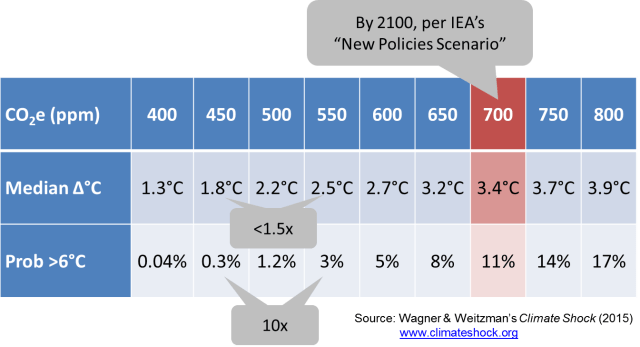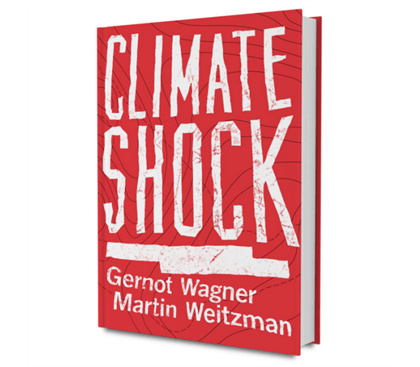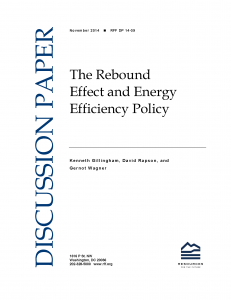By Gernot Wagner and Martin L. Weitzman
Each ton of carbon dioxide emitted into the atmosphere today causes about $40 worth of damages. So at least says standard economic thinking.
A lot goes into calculating that number. You might call it the mother of all benefit-cost analyses. It’s bean-counting on a global scale, extending out decades and centuries. And it’s a process that requires assumptions every step along the way.
The resulting $40 figure should be taken for what it is: the central case presented by the U.S. Government Interagency Working Group on Social Cost of Carbon when using its preferred 3% discount rate for all future climate damages. But it is by no means the full story.
Choose a different discount rate, get a different number. Yale economist Bill Nordhaus uses a discount rate of slightly above 4%. His resulting price is closer to $20 per ton of carbon dioxide. The Stern Review on the Economics of Climate Change uses 1.4%. The resulting price per ton is over $80.
And the discount rate is not the only assumption that makes this kind of a difference. In Climate Shock, we present the latest thinking on why and how we should worry about the right price for each ton of carbon dioxide, and other greenhouse gases, emitted into the atmosphere. There are so many uncertainties at every step—from economic projections to emissions, from emissions to concentrations, from concentrations to temperatures, and back to economics in form of climate damages—that pointing to one single, final number is false precision, misleading, or worse.
Of course, that does not mean that we shouldn’t attempt to make this calculation in the first place. The alternative to calculating the cost of carbon is to use a big fat zero in government benefit-cost calculations. That’s clearly wrong.
Most everything we know about what goes into calculating the $40 figure leads us to believe that $40 is the lower bound for sensible policy action. Most everything we know that is left out would push the number higher still, perhaps much higher.
It’s not over ’til the fat tail zings
As just one example, zero in on the link between carbon concentrations in the atmosphere and eventual temperature outcomes. We know that increasing concentrations will not decrease global temperatures. Thank you, high school chemistry and physics. The lower bound for the temperature impact when carbon concentrations in the atmosphere double can be cut off at zero.
In fact, we are pretty sure it can be cut off at 1°C or above. Global average temperatures have already warmed by over 0.8°C, and we haven’t even doubled carbon concentrations from preindustrial levels. Moreover, the temperature increases in this calculation should happen ‘eventually’—over decades and centuries. Not now.
What’s even more worrying is the upper tail of that temperature distribution. There’s no similarly definitive cut-off for the worst-case scenario. In fact, our own calculations (based on an International Energy Agency (IEA) scenario that greenhouse gas concentrations will end up around 700 parts per million) suggest a greater-than-10% chance of eventual global average warming of 6°C or above.
Focus on the bottom row in this table. If you do, you are already ahead of others, most of whom focus on averages, here depicted as “median Δ°C” (eventual changes in global average surface temperatures). The median is what we would expect to exceed half the time, given particular greenhouse gas concentrations in the atmosphere. And it’s bad enough.
But what really puts the “shock” into Climate Shock is the rapid increase in probabilities of eventual temperatures exceeding 6°C, the bottom row. While average temperatures go up steadily with rising concentrations, the chance of true extremes rises rapidly:

That 6°C is an Earth-as-we-know-it-altering temperature increase. Think of it as a planetary fever. Normal body temperatures hover around 37°C. Anything above 38°C and you have a fever. Anything above 40°C is life-threatening.
Global average warming of 3°C wouldn’t be unprecedented for the planet as a whole, in all of it geological history. For human society, it would be. And that’s where we are heading at the moment—on average, already assuming some ‘new policies’ to come into play that aren’t currently on the books.
It’s the high-probability averages rather than low-probability extremes that drive the original $40 figure. Our table links greenhouse gas concentrations to worryingly high probability estimates for temperatures eventually exceeding 6°C, an outcome that clearly would be catastrophic for human society as we know it.
Instead of focusing on averages then, climate ought to be seen as a risk management problem. Some greenhouse gas concentration thresholds should simply not be crossed. The risks are too high.
This kind of focus on temperature extremes is far from accepted wisdom. We argue it ought to be.
Gernot Wagner and Martin L. Weitzman are co-authors of Climate Shock (Princeton University Press, 2015). First published by The Institute for New Economic Thinking.










 Why is it so difficult to get people to worry about climate change? After all, the science is pretty unambiguous—pace the climate change “deniers”. Part of the problem, according to a new book, “
Why is it so difficult to get people to worry about climate change? After all, the science is pretty unambiguous—pace the climate change “deniers”. Part of the problem, according to a new book, “

